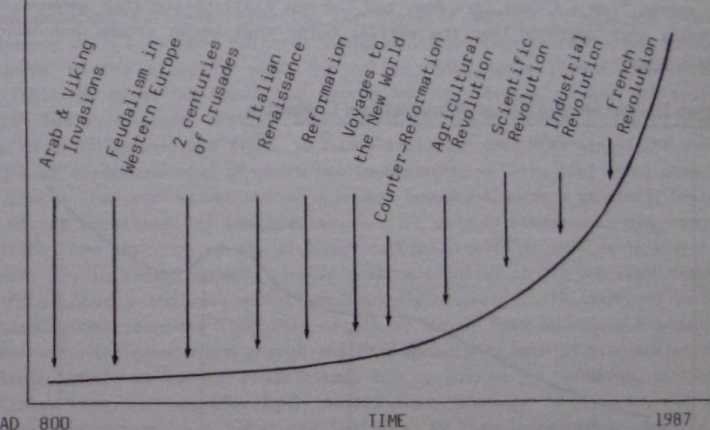IMGx46
264 The Origin of Civilisation
upwards on the ciuilisation gradient, and its unique status must be seen as relating to the galvanising effect it had upon the generally impouerished cultural climate of the day, a re-awakening aft er a prolonged stasis.
The continuing sequence of sectional spurts that dominated progress from 1378-1878 now become stages in a spasmodic exponential growth phase which culminated in the first fuli flowering of a ciuilisation genesis during the late Victorian era. Slowly, the Renaissance influence spread across Europę, and autocatalytic reactions gathered greater pace, beginning to raroify across all the five culture subsystems, until there were truły innovative elements present in each one. The preparatory phase took Five hundred years of con-tinuous change, before it generated a fuli explosive burst, the emergence of the early modern age, around 1878. This was coincidental with the first true leap on the civilisation trajectory. We saw above how crowded with excitingly new concepts, innouations, and inueńtions the bnef period, 1870-1920 had been. Yet it came after the aualanche of massiue changes which presaged the modern era, in which the agricultural, scientific and industrial reuolutions played so prominent a role.
Onto this sequence we can now graft the concept of Prigogine's dissipative structures for the social context of evolving civilisations. The initial 'proto-modern' phase of the Italian Renaissance can still be classed as a dissipative structure - the dying of the dominant old feudal order in con-junction with the incipient awakening of the new. But the first fifty years of this century prouides a morę classic example. It shows how the arbitrary diuisipns that we have erected fuse together to form the cohesiue totality of the fuli historical scenario. Thus, the recent, destructiue interlude of 1920-1944 represents the finał collapse of an old order re-eraerging as a new self-sustaining chain reaction. This is a second valid civilisation genesis consistent with our proposed terminology. This further rise along the stepped ascent has brought civilisation into the middle modern phase, but the ouerall mowement remains incomplete. The fuli, or late modern age may well involve another upward bound along the curve, as modernisation spreads to erabrace the entire Third World.
The continuum of turbulence and change extending forward from at least AD 800 to the present day, can thus be viewed as one unending exponential 'log' phase, erupting in an intermittent series of partial and total explosive climaxes. The early part of this period was built upon the fragmented remains of the Classical world, after its collapse in the fourth and fifth centuries AD. That ciuilisation was predominantly localised and autonomous, whereas the incipient ciuilisation that was coalescing during the period under reuiew, had all the makings of a truły International configuration. It began in a Southern European focus with the aduent of the Renaissance, but gradually, especially during this last century, it has acquired an even morę pronounced cosmopolitan aura. The period before 1378 would therefore be designated as a 'subcritlcal' ciuilisation, indicating its inherently intermediate status: an
interregnum uniting the Classical Graeco-Ronian ciuilisation to the modern age which is, euen now, embroiled in its delicate Lnfancy. These twelue hundred years have shown a decisiue, albeit rather patchy, sequence of progressiue aduances across euery one of the fiue culture subsystems. Howeuer, as this explanation suggests, the record of the journey to the present can be charted in two different ways. First, as a schematic typical sigmoidal curue, (Figurę 5.2) couering this entire period. It begins around AD 800, as Europę, both north and south, was still absorbing the latest tide of newcomers. Slowly, it began to reassemble the shattered pieces of its inherited imperial past, to moue gradually along the docile 'lag* phase of the sigmoidal curue, towards the morę robust and observable exponential 'log' phase.
All the massiue population upheauals that we drew attention to aboue, madę contributions to the autocatalytic Chain reaction that now became prominent. Hence, we can also show the process euoluing along the typical trajectory of a fuli culture curve. Figurę 5.3 suggests this expansion was the initial upsurge of the curue, corresponding to the long period when the modernising European nation States were drawing away from the limitations of feudalism.
Figurę S.2 The Sigmoidal Curue of AD 800 to 1987

The culture curue for medieual Europę then madę its first ciuilising leap, as Southern and then northern Europę moued towards a critical culture mass in the knowledge subsystem, but not in the other four. Yet seueral actiuities
Wyszukiwarka
Podobne podstrony:
20614 IMGx36 244 The Origin of Civilisation light on how the civilised states of AD 1488 differed fr
IMGx44 260 The Origin of Civilisation This is the scenario of the complete life cycle history, as ou
IMGx48 268 The Origin of Civilisatiou Armed with the theoretical base we have now built, this concep
IMGx57 286 The Origin of Civilisation 26. 8.Cohen, 1987, pp 140-Ul. 27.
13595 IMGx32 236 The Origin of Civilisation directions, inventing a prodigious number of indispensab
IMGx29 230 The Origin of Civilisation with a hierarchy of sites mirroring the hierarchy of social ro
IMGx34 240 The Origin of CivilisationCivilisation Under Romę As the Babylonians inherited the manile
IMGx37 246 The Origin of Civilisation are all graphic i 1lustrations of autonomous rising cultures m
IMGx45 262 The Origin of CiviLisation from the capitulation of Damascus (AO 635) to the wic tory eas
IMGx57 286 The Origin of Civilisation 26. 8.Cohen, 1987, pp 140-Ul. 27.
60119 IMGx31 234 The Origin of Civilisation Whetewer the detail of the actiwating mechanism, what ma
74085 IMGx56 284 The Origin of Civilisation In theory, there musi be sonę limit to the number of ris
więcej podobnych podstron